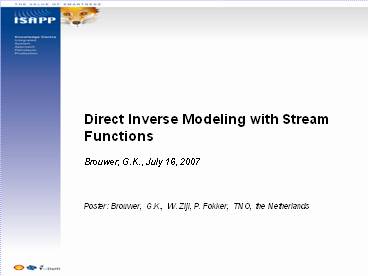Direct Inverse Modeling with Stream Functions PowerPoint PPT Presentation
Title: Direct Inverse Modeling with Stream Functions
1
,
Direct Inverse Modeling with Stream
Functions Brouwer, G.K., July 16, 2007 Poster
Brouwer, G.K., W. Zijl, P. Fokker, TNO, the
Netherlands
2
,
Contents Intro well measurements, processes,
inversion Revival of stream function Direct
inversion with the Double Constraint Constraints
(P,Q), (water cut) Example assimilating water
cut measurements Conclusions Future work
3
,
- Well data in an oil reservoir with water
injection - Pressure (t), or flow potential f (t)
- Flow oil (t), or Qo (t) (flux), qo(t) (flux
density) - Flow water (t)
- Two dynamical processes with (very) different
time scale - Pressure propagation
- displacement of the phases
- Direct inversion model (Darcy)
- kvtot/(flow potential gradient) or
4
,
l1
l2
(qydy/dx0) qx-dy/dyconst df/dx/const
k1
k2
w
Finding k in flow direction k is hidden in
f Solve by requiring S(li/ki)constant at all
times (M/1)
l
Finding k perpendicular to flow An arrival time
(y) problem !
5
,
Solving y
Implemented in MoReS prescribed boundary
conditions
6
,
Double constraint (Wexler, 1985, medical
application)
pressure BC (wells) gt guessed pressure field
f(x,y)
(MoReS pot. run)
posterior perm field k (x,y)
iterate
prior permeability field k (x,y)
flux BC (wells) gt guessed flow field vx, vy or
y(x,y)
(MoReS flow run)
7
,
Constraining on P, Q
For each stream tube
j porosity DSSbf-Swc Vvolume
8
,
Correcting on wells first arrival stream tube
travel time by changing dy/ds
Apply DC
iterate
9
,
LINE truth Blue circles assim. of fluxes and
pressures Blue squares restored watercut
10
,
- conclusions
- double constraint honours hard data
- Water cut ( saturation fronts from 4-D
seismics) can be assimilated - methodology can be applied with any forward
simulator - (pressures and velocities have to be available)
- recommendations
- reformulation for 3-D
- software development for 3D, multi- phase flow
- (prototype 3-D available)
- integrate with (extended) Kalman filter
- explore DC for upscaling
PowerShow.com is a leading presentation sharing website. It has millions of presentations already uploaded and available with 1,000s more being uploaded by its users every day. Whatever your area of interest, here you’ll be able to find and view presentations you’ll love and possibly download. And, best of all, it is completely free and easy to use.
You might even have a presentation you’d like to share with others. If so, just upload it to PowerShow.com. We’ll convert it to an HTML5 slideshow that includes all the media types you’ve already added: audio, video, music, pictures, animations and transition effects. Then you can share it with your target audience as well as PowerShow.com’s millions of monthly visitors. And, again, it’s all free.
About the Developers
PowerShow.com is brought to you by CrystalGraphics, the award-winning developer and market-leading publisher of rich-media enhancement products for presentations. Our product offerings include millions of PowerPoint templates, diagrams, animated 3D characters and more.

